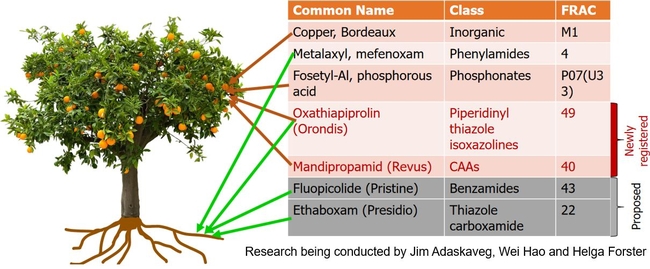California is in a severe winter storm making conditions ideal for diseases caused by Oomycetes, also called water molds, especially Phytophthora species, which thrive in waterlogged soils and areas with standing water for periods of time. During moist conditions, large numbers of motile zoospores, which can swim in water for short distances, are produced. Zoospores are carried in irrigation or rainwater to the fruit, crown, and roots. Inoculum levels and wetness length are the most important predictors of brown rot epidemics. Unfortunately, Phytophthora species can be found on most orchards in the state. They cause trunk canker, gummosis, and crown, root, and fruit rots on citrus.
To manage Phytophthoradiseases, moisture management is foremost. Control of Phytophthora diseases are extremely difficult, even with the use of fungicides, in the wet weather conditions. In the past few years, researchers from UCR have work on a number of new fungicides, with new active ingredients, to be used in the management of Phytophthora diseases. Management of Phytophthora diseases can also be accomplished through cultural control. It is important to improve soil drainage. Adequate drainage includes both surface and subsoil drainage. Surface drainage is necessary to remove excess surface water rapidly during and after heavy rains. This is usually accomplished by
planting on bedding unless the natural topography has a slop and diverting surface water into collection ditches. Rain water that soaks into the soil and raises the water table must be removed by subsurface drainage. This can be done through the use of subsurface drains or open ditches.
Attached Images:
